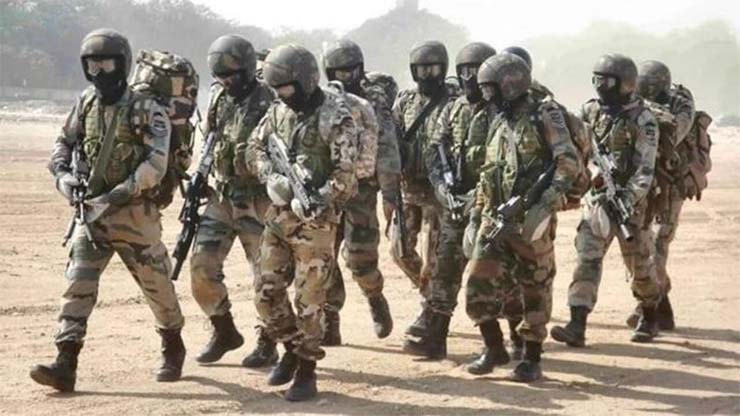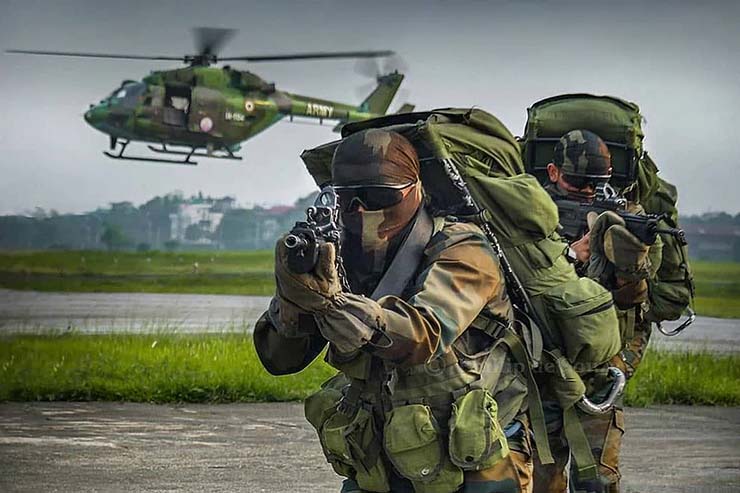
Special Frontier Force (SFF) or Establishment 22 – is a highly secret organisation comprising of Tibetan and Gurkha commandoes and mountain climbers trained in mountain warfare and covert operations behind enemy lines against the Chinese in the Himalayas. The force headed by an Inspector General or Major General reports directly to the Prime Minister’s Office through the directorate general of security in the Cabinet Secretariat.
Each one of the Special Frontier Force (SFF) or Establishment 22 members is a trained commando, mountaineer and paratrooper highly skilled in rock climbing and guerrilla warfare. The SFF’s mission is always a closely guarded secret that even the army does not know what it’s up to.
Each battalion of SFF comprising Tibetans and Gurkhas from Nepal has around 800 troopers.
The Establishment 22 was created as per the advice of the Intelligence Bureau Chief Bhola Nath Mullik, defence minister Krishna Menon and Biju Patnaik a 46-year-old Royal Indian Air Force pilot who was close to Pt Jawahar Lal Nehru (Biju Patnaik later went on to be the Chief Minister of Odisha) to conduct covert operations in the event of a war with China. Gen K S Thimayya the 3rd Chief of the Army Staff from 1957 to 1961 favoured the idea of raising a specialized force of Tibetan Tibetan resistance fighters against China.
At their behest, Nehru gave the approval for the creation of Establishment 22 at Chakrata which was selected as the secret base for training the Tibetan volunteers under the Indian Army. Accordingly, Establishment 22 came into being on PM Nehru’s 73rd birthday on 14 November 1962 in the midst of the Indo-China War (20 Oct 1962 – 21 Nov 1962).
Nehru was reportedly so disturbed by the 1962 war that he sent two letters to Washington, DC, urging the USA to intervene. The Kennedy administration sent a delegation to India comprising Defence Secretary Robert McNamara and CIA chief John McCone to Delhi. At their behest, India agreed to support Tibetan refugees and revolutionaries settled in India to fight the common enemy. Thus Nehru ordered the raising of an elite Indian-trained “Tibetan Armed Force” composed of Tibetan refugees. This led to the birth of SFF at Chakrata 100 km away from Dehradun and Aviation Research Centre (ARC) another clandestine RAW outfit at Charbatia, an old and unused WW2 airfield, 10km north of Cuttack (Odisha) around the same time.
Soon the first batch of over 5,000 dreaded Khampa warriors started training under the Indian commando trainers and CIA at Chakrata – the hometown of the 4th Gorkha Rifles regimental centre in present-day Uttarakhand. The CIA provided the initial support as well as arms, and ammunition like M-1, M-2 and M-3 sub-machine guns and other battle logistics.
In the initial stages immediately after the 1962 war the Special Frontier Force (SFF) was controlled by the Intelligence Bureau but was later placed under the Research and Analysis Wing (RAW) and the Cabinet Secretariat.
It was called Establishment 22 or 22 by its commandant Major General Sujan Singh Uban who had raised and led the 22nd Mountain Division of the Royal Indian Artillery during World War II in Europe.
The SFF units have their own rank structures, equivalent to the Indian Army but are not part of the Indian Army.
It has its own training facilities and SFF recruits both men and women are trained to perform all possible tasks like irregular guerrilla warfare, para trooping, intelligence gathering, surveillance and other subversive activities that any Special Forces unit can be expected to perform.
The 1971 operation:
During the 1971 war, as part of ‘Operation Mountain Eagle’ about 3,000 Special Frontier Force personnel were airlifted into the operational areas in the Chittagong hill tract in East Pakistan — now part of Bangladesh to neutralise the Pakistan army positions and help the Indian Army advance forward. The SFF troopers infiltrated behind enemy lines to destroy the Pakistan Army’s communication lines and ensured that the Pakistan army personnel in Bangladesh did not escape to Burma.
The SFF fought fiercely and lost about 56 men, including a Dapon (a rank equivalent to a brigadier); nearly 190 were wounded in the war.
The SFF personnel destroyed a number of dams and bridges of strategic importance and trained the local underground unit called Mujib Bahini- earning the nickname Phantoms of Chittagong.
Other operations:
The SFF personnel have been involved in a number of operations – some of which are known but many more remain buried in top secret or classified files.
For the record Prime Minister Indira Gandhi is understood to have engaged SFF as a “Personal Force” to suppress opposition parties during the state of emergency in the mid-70s.
SFF personnel took part in Operation Blue Star inside the Golden Temple in Amritsar and were briefly used for VIP security duties around the Prime Minister immediately after the assassination of Indira Gandhi before the task was handed over to the Special Protection Group (SPG).

To ensure secrecy about the SFF and its style of functioning a rule is understood to have been passed in 1975 prohibiting the deployment of SFF anywhere within 10 kilometres of the Indo-China border unless specifically ordered to do so in an emergency situation.
The SFF personnel are also understood to have played a part in Operation Meghdoot in the Siachen glacier in 1984 and Operation Vijay against Pakistan in the Kargil War which ended on July 26, 1999, after the eviction of the Pakistan Army from Indian soil.
The paratroopers of the elite Special Frontier Force (SFF) suffered one of the first casualties in the China–India skirmishes in 2020–2021.
Though a few SFF soldiers were given gallantry awards for their role in Siachen and Kargil, most others like Nyima Tenzin who died in a landmine blast during a reconnaissance mission along the line of actual control remain unsung heroes. Their names did not figure in the lists of martyrs because of the secret nature of their force.
Yatish Yadav an investigative journalist and author in his book ‘RAW: A History of India’s Covert Operations’ mentions the dilemma in the mind of Prime Minister Atal Bihari Vajpayee and his national security advisor and principal secretary Brajesh Mishra on how to recognize supreme sacrifice of SFF personnel in the Kargil war. Finally, for the first time in the history of the R&AW, special medals were presented to eighteen SFF warriors whose names were read out in a closed conference room at the prime minister’s official residence at 7 Race Course Road.
According to Yadav, Vajpayee simply shook hands with top R&AW officers and expressed his deep gratitude for their supreme sacrifice. But no records of the meeting were kept. No press release was issued or photographs were published on the PMO website. After the ceremony, the officers quietly retreated to their invisible world taking their secrets to bed.
One of the exceptions to the rule of course was Tsering Norbu whose name was “Mentioned in despatches” on 26 January 2021, for his contribution in Operation Snow Leopard.
-The writer is a seasoned media professional with over three decades of experience in print, electronic, and web media. He is presently Editor of Taazakhabar News








